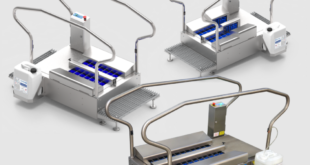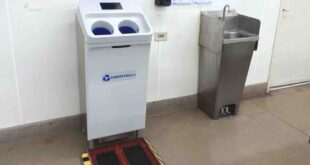To prepare for success, businesses must take steps to address today’s top manufacturing challenges. Eddie Storan explores these challenges and discusses the steps to take and the technology to create tomorrow’s workplaces
The manufacturing industry has suffered significant challenges over the past few years. Supply chain vulnerabilities, labour shortages, pressures of COVID-19, and ongoing global political upheavals have created a very challenging and uncertain economic outlook.
Despite this, global production is growing at a steady pace. In September 2022, the United Nations Industrial Development Organization reported a 3.1% year-on-year increase in global manufacturing output1, with end-of-year figures likely to surpass pre-pandemic levels.
Supply chain turbulence
Supply chain turbulence is one of the greatest challenges facing manufacturers. From COVID-19 and the Suez Canal blockage to the energy crisis and the Ukraine conflict – the last few years have seen a series of unprecedented events that have wreaked havoc in supply chains with very little resiliency. In the UK, the ONS reported that between February 2021 and February 2022, 16% of businesses reported global supply chain disruption2.
Such disruptions can negatively impact manufacturing operations and cause knock-on effects on consumers via increased prices and extended lead times. Smart systems and automation are ways to mitigate some of these causalities.
Using automation can increase both control and agility by creating trusted, repeatable production processes that improve efficiency and reduce the risk of expensive errors. Automated coding solutions, for example, are a way of achieving this by limiting the risk of coding errors and associated downtime. When used to integrate and connect production machinery, automated coding can also provide manufacturers with options for increased data sharing and visibility of what is happening in real-time on a production line. These factors combine to fuel more efficient manufacturing operations.
These solutions can also provide critical business insight that can help manufacturers cope with changes in demand or disruptions in supply. Data gleaned from automated coding, including the number of items coded per day, provides the insight needed to pre-plan production runs, and help ensure the right amount of inventory and consumables to keep production lines running smoothly.
Staff shortages
Businesses in all industries are currently facing a shortage of workers – but the manufacturing sector has been hit particularly hard. In a recent report, Deloitte estimated that the US manufacturing skills shortages could reach a shortfall of 2.1 million skilled jobs by 2030.
Automation, augmented reality, and cloud computing can provide a way of mitigating this risk to business productivity. When used effectively, these technologies can help manufacturers to overcome issues and maintain or improve production line efficiency.
Manufacturers can automate systems to work with limited operator intervention and take care of routine, manual tasks so that systems can continue to operate despite a reduced number of workers. It’s not about replacing manual workers – but ensuring that the existing manufacturing company workforce is put to the best use rather than carrying out mundane tasks which can easily be automated.
Companies can also look to their equipment suppliers to lend a hand in keeping machines running smoothly without significant operator intervention. During the pandemic, innovative suppliers developed ways of providing remote support applications, using augmented reality to allow engineers to interact with production line staff and resolve issues with machinery in real time or, on matters necessitating a site visit, to arrive on-site with everything needed to fix the issue. The use of augmented reality can also help to lessen customer training needs.
Remote monitoring via the cloud can also help to keep production running smoothly with a reduced workforce. Machines equipped with cloud connectivity can provide data on overall throughput, monitor performance, and use alerts and emails to notify of any changes which could signify – or, if not addressed, result in – an item of machinery not operating correctly. This helps to avoid unnecessary downtime and keep production lines running at full capacity.
Quality control
Ensuring high levels of quality in everything from manufactured goods to product packaging and final coding and labelling is a high priority in any manufacturing environment. Consumer, retailer, and regulatory requirements and concerns around product safety and quality are higher than ever – and the pressure is on manufacturers to ensure that any product that leaves the factory is produced to the required standard.
Any manufacturing line needs rigorous quality and control processes, including product inspection. Automating inspection via intelligent machine vision systems is the most effective way to facilitate this. In coding and marking, such systems allow manufacturers to ensure that their products are adequately coded and can also help to identify where other issues on the line could be leading to coding issues. For example, a problem with box assembly results in incorrect code placement.
Vision inspection systems can be set up to provide automated alerts or automatic line stops when a specified error threshold is reached. This allows production workers to verify where on the production line an issue may be arising and take preventative action to rectify the problem. The risk of a sub-optimal product leaving the factory unnoticed is reduced as is the production of waste.
Production (in)efficiency
Growth and competitiveness go hand in hand with production efficiency – or mitigating inefficiency. No matter how large or small a manufacturing plant is, efficiency and productivity will always be vital in maintaining a competitive edge.
The most effective means to facilitate this is data collection and analysis via cloud computing. Cloud dashboards allow manufacturers to track performance across production lines and understand how processes work effectively. This helps to keep things running smoothly and to identify areas for improvement, including opportunities to reduce waste and increase productivity.
Production managers can use cloud data to observe how a machine functions in real-time and identify changes in output that may signify a problem. The same technology will also accumulate a wealth of historical production data when utilised over time, which can be used for scenario planning and simulation to provide insight into additional value-added services that maximise overall equipment effectiveness.
Over time, data analysis and collaborative action between manufacturers and equipment providers can be used to develop the optimal conditions for production, with minimal downtime, reduced waste, and consistently high-quality products.
Sustainability
Though perhaps compounded in recent years, these four challenges are not necessarily anything new to manufacturers. Arguably, they pale in comparison to the question of how best to achieve a sustainable production line and the goal of net zero.
The good news is that many of the tools and systems available to help manufacturers overcome the more common production challenges and remain competitive can also lend a hand regarding sustainability, efficiency, and waste reduction.
Whether through augmented reality support to reduce road miles needed to facilitate a machine fix; vision inspection to identify and rectify causes of production waste; or remote monitoring and data collection via the cloud to help identify and maintain consistently high quality across production lines, automation and smart solutions provide an excellent backbone for sustainable production.
Manufacturers who optimise their production via these systems and processes will be better placed to meet net zero targets and better manage suppliers and costs – by ensuring that all materials and energy are used to create high-quality, consumer-ready products rather than waste.
Conclusion
The most prominent challenges facing manufacturers today can be addressed through automation and intelligent use of data, but it is not easy to do this alone. Partnering with a trusted, reliable partner with experience working with smart systems, their relevant stages of application, and how these apply to individual sectors can play a key role in overcoming today’s manufacturing challenges and preparing for the workplace of tomorrow.
1. https://stat.unido.org/content/publications/world-manufacturing-production
2. https://www.ons.gov.uk/businessindustryandtrade/business/businessservices/bulletins/businessinsightsandi
mpactontheukeconomy/16june2022/pdf
Eddie Storan is Director of Global Service, Domino Printing Sciences.
 Engineer News Network The ultimate online news and information resource for today’s engineer
Engineer News Network The ultimate online news and information resource for today’s engineer





